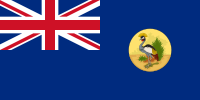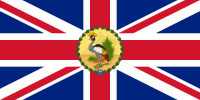Flag of Uganda
 | |
| Use | National flag and ensign |
|---|---|
| Proportion | 2:3 |
| Adopted | October 9, 1962 |
| Design | Six equal horizontal bands of black (top), yellow, red, black, yellow, and red (bottom); a white disc is superimposed at the centre and depicts the national symbol, a grey crowned crane, facing the hoist side. |
| Designed by | Grace Ibingira |

The flag of Uganda was adopted on 9 October 1962, the date that Uganda became independent from the United Kingdom. It consists of six equal horizontal bands of black (top), yellow, red, black, yellow, and red (bottom); a white disc is superimposed at the centre and depicts the national symbol, a grey crowned crane, facing the hoist side.
During the colonial era the British used a British Blue ensign defaced with the colonial badge, as prescribed in 1865 regulations. Buganda, the largest of the traditional kingdoms in the colony of Uganda, had its own flag. [1] However, in order to avoid appearing to give preference to one region of the colony over any other, the British colonial authorities selected the crane emblem for use on the Blue ensign and other official banners.[2]
History
When the Democratic Party ruled the country, a design for flag was proposed. It had vertical stripes of green-blue-green, separated by narrower yellow stripes, and in the centre had the silhouette of a yellow crane. After the party lost the national elections on April 25, 1962 the newly elected Uganda People’s Congress (UPC) rejected the former design and instead proposed the current design. It was based on the flag of UPC– a tricolor having horizontal strips of red, yellow and black. The British administration gave their approval to this design before the country's independence. The flag was designed by the Ugandan Minister of Justice, Grace Ibingira.[2]
Symbolism
The three colours are representative of African peoples (black), Africa's sunshine (yellow), and African brotherhood (red being the colour of blood, through which all Africans are connected).[3] The grey crowned crane is fabled for its gentle nature and was also the military badge of Ugandan soldiers during British rule. The raised leg of the crane symbolizes the forward movement of the country.[4]
Other flags
-

Flag of the Uganda Protectorate (1914-March, 1962)
-

Standard of the Governor of Uganda (1914 - March, 1962)
-

National flag (March - October 9, 1962)
-

Presidential Standard of Uganda
Similar Flags
|
References
- ↑ "Buganda (Uganda)". FOTW Flags Of The World website. Retrieved 31 August 2015.
- 1 2 "flag of Uganda". Encyclopaedia Brittanica. Retrieved 14 September 2014.
- ↑ Uganda at Flags of the World
- ↑ "Uganda National Symbols". Uganda Mission. Retrieved 14 September 2014.

